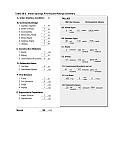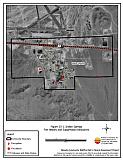25.0 Indian Springs
25.1 Risk and Hazard Assessment
The community of Indian Springs lies 45 miles northwest of Las Vegas on US Highway 95. Indian Springs is located adjacent to an Air Force base installation. The community hazard assessment resulted in classifying Indian Springs in the Low Hazard category (34 points). The low rating is primarily attributed to good access, fire-resistant building materials, adequate water for fire suppression, and sparse vegetation. A summary of the conditions that contributed to the hazard rating for Indian Springs is included in Table 25-3 at the end of this section. The Indian Springs community boundary is shown in Figure 25-1.
25.1.1 Community Design
The urban interface condition surrounding Indian Springs is a classic interface condition. There is a clear line of demarcation between building structures and wildland fuels. Wildland vegetation typically does not continue into the development areas. All residential lots are on parcels of less than one acre in size.
- Access: Indian Springs lies along US Highway 95, a paved four-lane road. The secondary roads are paved and there is adequate room for fire suppression equipment to maneuver.
- Signage: All of the streets have clearly posted and visible signs. Only 76 percent of the homes have address signs that are visible from the road.
- Utilities: Utilities are both above and below ground. Utility corridors were well maintained and pose a low ignition risk.
25.1.2 Construction Materials
Ninety-nine percent of the homes in the interface are built with non-combustible roofing and 93 percent are constructed of non-combustible siding materials.
Nearly half of the homes in the community have unenclosed balconies, porches, decks, or other architectural features that create drafts and provide areas where sparks and embers can be trapped, smolder, ignite, and rapidly spread fire to the home.
25.1.3 Defensible Space
Eighty-six percent of the homes assessed have landscaping that meets the minimum requirement for defensible space to minimize property damage or the risk of loss to the home during a wildfire.
25.1.4 Suppression Capabilities
Wildfire Protection Resources
Indian Springs has a local volunteer fire department, Station 83 that reported having 36 members at the time that interviews were conducted for this report. The community also relies on fire protection from the nearby Indian Springs Air Force Auxiliary Field. Additional resources are available through the Clark County Fire Department and the Nevada Division of Forestry Indian Springs Conservation Camp. Table 25-1 lists the types of wildfire resources, cooperating partners, and equipment available to Indian Springs to respond to a reported wildland fire. Response times depend on firefighter availability.
| Type of Equipment | Amount of Equipment | Cooperating Partner (Resource Location) |
|---|---|---|
| Type 1 Structure Engine Type 6 Quick Attack Engine ILS Rescue |
1 1 1 |
Clark County Rural Fire Station 83 (Indian Springs) |
| Type 4 Brush Engine Type 6 Brush Patrol Engine |
1 1 |
US Forest Service (Indian Springs Station 83) |
| Source: Steve McClintock, Kurt Leavitt, Mark Blankensop, pers. comm. March 2004. | ||
Mutual aid can be requested from the US Forest Service, the National Park Service, and the Bureau of Land Management through the Las Vegas Interagency Communications Center. The Nevada Division of Forestry also provides mutual aid dispatched from the Sierra Front Interagency Dispatch Center in Minden, Nevada, which locates the nearest available fire suppression resource according to incident command and computer aided dispatch protocols. It is important to note that these resources can be assigned to other emergency incidents during the fire season.
Water Sources and Infrastructure
Water available for fire suppression in Indian Springs includes fire hydrants within 500 feet of structures with minimum flow capacities of 500 gpm, community wells with electric pumps, and 40,000 gallon storage tanks
Fire Protection Personnel Qualifications
The firefighters have a minimum of NFPA Firefighter I and II training and a limited number of volunteer firefighters have some have wildland firefighting training (National Wildfire Coordinating Group 310-1). The National Red Card wildland certification system is used once a volunteer receives the appropriate training.
Work Load
In 2003 the Indian Springs Fire Department responded to 42 emergency medical calls and thirteen wildland brush fire calls.
Financial Support
Annual operating funds for the Clark County Fire Department comes from the County General Fund, which is generated through the collection of property taxes.
Community Preparedness
Indian Springs is covered under the Clark County All-Risk Emergency Plan. The Clark County Fire Department reviews development plans for the entire county to ensure compliance with the 1997 (with amendments) Uniform Fire Code standards. There are no brush clearance programs in Indian Springs.
25.1.5 Factors Affecting Fire Behavior
The vegetative community in the Indian Springs area is Mojave Desert shrub, consisting of a sparse distribution of creosote bush fourwing saltbush, greasewood, and occasional mesquite trees. The fuel density is light, estimated at less than one ton per acre, and considered a low fuel hazard. Much of the fuel loading in Indian Springs is composed of annual grasses and other plants on vacant lots within the community, which, when unmanaged, dry out and pose a high risk of ignition.
25.1.6 Fire Behavior Worst-case Scenario
The worst-case scenario for Indian Springs would be a fire ignition in one of several vacant lots present within the community that accumulated a higher fuel load. Strong winds from the south/southwest could drive the fire through the rest of the community.
25.1.7 Ignition Risk Assessment
Indian Springs has a low wildfire ignition risk potential. There is no significant wildfire history reported in the area surrounding the community, though there are two ignitions recorded in the interface. The low ignition potential is facilitated by the low, sparse brush in and around the community.
25.2 Risk and Hazard Reduction Recommendations
The hazard reduction recommendations for Indian Springs focus on fuel reduction and defensible space. The recommendations are described in detail below.
25.2.1 Defensible Space Treatments
Defensible space treatments are an essential first line of defense for residential structures. The goal of the treatments is to significantly reduce or remove flammable vegetation within a prescribed distance from structures. (Refer to Appendix E for the recommended defensible space area). Defensible space reduces the fire intensity and improves firefighter and homeowner chances for successfully defending a structure against oncoming wildfire.
Property Owners
- Remove debris and flammable materials from within the defensible space area.
- Immediately dispose of cleared vegetation when implementing defensible space treatments. This material dries quickly and poses a fire risk if left on site.
- Maintain this defensible space as needed to keep the space lean, clean, and green.
- Maintain the areas underneath decks, porches, etc. free of weeds and other flammable debris to prevent sparks lodging, smoldering, and spreading fire to the home.
- Clear vegetation and combustible materials around propane tanks for a minimum of ten feet.
- Ensure that residential addresses are visible from the road. Address characters should be at least four inches high, reflective, and posted where the road and driveway meet. Improving visibility of addresses will make it easier for those unfamiliar with the area to navigate during a wildland fire.
25.2.2 Fuel Reduction Treatments
Property Owners and Indian Springs Volunteer Fire Department
- Remove and reduce flammable vegetation and debris in vacant lots in the community. Reseed with fire-resistant species such as the mixture recommended in Appendix E if necessary to control annual plant reestablishment.
25.2.3 Fire Suppression Resources
Clark County Fire Department
- Provide all firefighters with basic wildland fire training and equipment as described in the National Wildfire Coordinating Group (NWCG) Wildland and Prescribed Fire Qualification System Guide 310-1. Provide annual wildland firefighting refresher training and fire shelter training.
25.2.4 Public Education
Clark County Fire Department
- Distribute copies of the publication “Living With Fire”. This publication is free of charge. Copies can be requested from the University of Nevada Cooperative Extension.
25.3 Summary of Recommendations
| Involved Party | Recommended Treatment | Recommendation Description |
|---|---|---|
| Property Owners |
Defensible Space | Remove, reduce, or replace flammable vegetation to create a buffer zone around residences and outbuildings in the interface according to the guidelines in Appendix E of this report. Maintain defensible space around residences and outbuildings as needed to keep the space lean, clean, and green. Ensure that addresses are clearly visible from the street. Clear vegetation from vacant lots within the community. |
| Clark County Fire Department | Fire Suppression Resources | Provide all firefighters with basic wildland fire training and equipment. |
| Public Education | Distribute copies of the publication “Living With Fire” to all property owners. | |
| Indian Springs Volunteer Fire Department | Fuels Reduction | Coordinate programs to clear flammable vegetation and debris from vacant lots within the community. |
Table 25-3. Indian Springs Wildfire Hazard Rating Summary |
 |
Figure 25-1 Indian Springs Fire History and Suppression Resources |
 |
